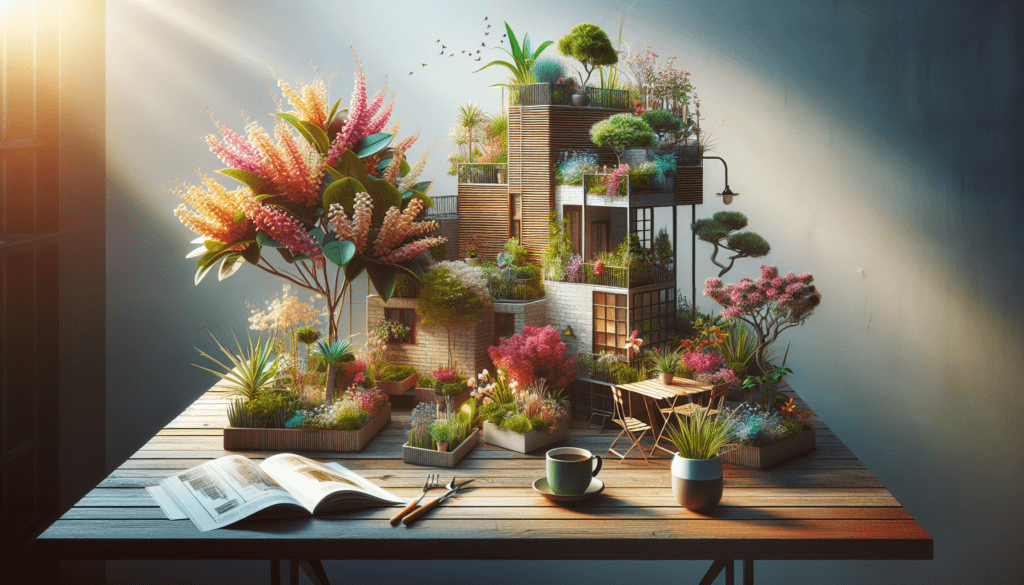Are you tired of spending hours tending to your garden? If so, we have just the solution for you. In this article, we will show you how to create a low-maintenance urban garden that will thrive with minimal effort. Say goodbye to constant weeding and watering, and hello to a beautiful oasis right in your own backyard. With a few simple tips and tricks, you can transform your space into a haven of greenery that requires little work to maintain. So put away your gardening gloves and get ready to enjoy a stress-free and vibrant urban garden.
Selecting the Right Plants
Choosing native plants
When selecting plants for your urban garden, it’s important to consider choosing native species. Native plants are adapted to the local environment and require less maintenance and resources compared to non-native species. They are more likely to withstand local weather conditions, soil types, and pests, making them an excellent choice for a low-maintenance garden. Additionally, native plants attract local wildlife, such as birds and butterflies, which can add beauty and biodiversity to your urban space.
Considering plant hardiness zones
Another important factor in selecting the right plants for your urban garden is to consider the plant hardiness zones. These zones, determined based on minimum winter temperatures, indicate which plants are most likely to thrive in your area. By choosing plants that are well-suited to your specific hardiness zone, you can ensure their successful growth and reduce the need for extensive care and maintenance.
Opting for drought-tolerant plants
In an urban environment, water conservation is crucial. Choosing drought-tolerant plants can significantly reduce your garden’s water requirements, making it more sustainable and low-maintenance. Many native plants are naturally adapted to survive with minimal watering, once established. Look for plants that have features like deep root systems or waxy leaves, as these are often indicators of drought-tolerance.
Selecting low-maintenance perennial plants
Perennial plants are a great choice for low-maintenance gardening. They come back year after year, eliminating the need for replanting and reducing the effort required to maintain your garden. Perennials also tend to require less water and fertilizer compared to annuals, making them an eco-friendly option. Consider selecting a variety of perennial plants with different bloom times to ensure your garden has color and interest throughout the year.
Using self-seeding plants
Self-seeding plants are a smart choice for a low-maintenance urban garden. These plants produce seeds that can germinate and grow new plants without any intervention from you. By allowing these plants to self-seed, you can enjoy a natural and ever-changing garden without the need for constant replanting. Some common self-seeding plants include poppies, cosmos, and forget-me-nots.
Planning the Garden Layout
Analyzing sunlight and shade patterns
Before designing your urban garden, it’s essential to analyze the sunlight and shade patterns in your outdoor space. Observe how the sun moves across your garden throughout the day to identify areas that receive full sun, partial shade, or full shade. This information will help you determine which plants will thrive in different areas of your garden, ensuring their optimal growth and minimizing the need for constant adjustments or relocations.
Utilizing vertical space
In urban settings where space is often limited, utilizing vertical space is a smart strategy to maximize your garden’s potential. Consider incorporating vertical gardening techniques such as trellises, hanging baskets, or climbing plants to add layers and visual interest to your garden. Vertical gardening not only allows you to grow more plants in a smaller area but also makes maintenance tasks more accessible, as you won’t have to bend down as often.
Creating defined paths and seating areas
To create an organized and aesthetically pleasing urban garden, it’s important to plan and create defined paths and seating areas. Well-defined paths provide easy access to different areas of your garden and prevent trampling of plants. Similarly, designated seating areas can be a welcoming space for relaxation and enjoyment. By incorporating these elements into your garden layout, you can make maintenance tasks more convenient and ensure your garden is both functional and beautiful.
Implementing raised beds or containers
Raised beds or containers are an excellent option for urban gardens, especially if you have limited or poor-quality soil. They allow you to control the soil composition, drainage, and pests more effectively. Additionally, raised beds and containers can be elevated, making gardening tasks more accessible and reducing strain on your back and knees. They also tend to have fewer weed problems, saving you time and effort in maintenance.
Considering access and storage needs
When planning your urban garden, it’s important to consider your access and storage needs. Ensure that you have easy access to all areas of your garden, including those that may require maintenance or harvesting. Additionally, consider incorporating storage solutions, such as sheds or cabinets, to keep your gardening tools, supplies, and equipment organized and protected. By addressing these needs in your garden layout, you can enhance the efficiency and enjoyment of your low-maintenance urban garden.

Preparing the Soil
Testing the soil composition
Before planting anything in your urban garden, it’s crucial to test the soil composition. Soil testing will provide valuable information about its pH level and nutrient content. Understanding the soil composition allows you to make informed decisions about amending the soil and selecting the right plants. You can purchase DIY soil testing kits or send soil samples to a local agricultural extension office for professional analysis.
Amending the soil with organic matter
Amending the soil with organic matter is a key step in preparing your urban garden for low-maintenance gardening. Organic matter, such as compost or well-rotted manure, improves soil structure, enhances drainage capabilities, and provides essential nutrients to plants. By incorporating organic matter into your soil, you create a healthy and fertile environment that promotes plant growth and reduces the need for additional fertilizers.
Using mulch to retain moisture
Mulching is an effective technique to retain moisture in the soil, suppress weed growth, and regulate soil temperature. Apply a layer of organic mulch, such as wood chips or straw, around your plants to help conserve water and keep the soil moist for a longer period. Mulch also improves soil health over time as it gradually breaks down and enriches the soil with organic matter.
Applying slow-release fertilizers
For a low-maintenance urban garden, using slow-release fertilizers can minimize the need for constant fertilization. Slow-release fertilizers gradually release nutrients into the soil, providing a steady supply to your plants over an extended period. This reduces the frequency and effort required for applying fertilizers and ensures that your plants receive adequate nourishment throughout their growth.
Avoiding chemical pesticides and herbicides
To maintain a healthy and environmentally friendly urban garden, it’s best to avoid chemical pesticides and herbicides. Instead, opt for natural pest control methods, such as companion planting or introducing beneficial insects. Physical barriers, such as netting or floating row covers, can also be effective in preventing pest damage. Embracing organic pest control methods not only supports pollinators and beneficial organisms but also reduces the risk of chemical exposure for you and your family.
Watering Techniques
Installing drip irrigation systems
Drip irrigation systems are an efficient way to deliver water directly to the roots of your plants. They reduce water waste by reducing evaporation and runoff and provide plants with a slow, steady water supply. By installing a drip irrigation system in your urban garden, you can save time, money, and water while ensuring that your plants receive adequate hydration.
Utilizing watering timers
Watering timers are a useful tool in managing a low-maintenance urban garden. They allow you to automate the watering process, ensuring that your plants receive water consistently and in the right amounts. Watering timers can be programmed to irrigate your garden during optimal times, such as early morning or late evening, when evaporation is minimal. This not only conserves water but also minimizes the effort required in manually watering your plants.
Conserving water with rain barrels
Rain barrels are an eco-friendly and cost-effective way to collect rainwater for your urban garden. They capture rainwater from rooftops and gutters, which can then be used for watering plants during dry periods. By utilizing rain barrels, you can conserve water, reduce your water bill, and provide your plants with a natural and chemical-free water source.
Implementing self-watering containers
If you have limited space or prefer container gardening in your urban garden, consider implementing self-watering containers. These containers have a reservoir at the bottom that stores water, which is then absorbed by the plant’s roots as needed. Self-watering containers reduce the frequency of watering and help maintain consistent soil moisture levels, making them ideal for a low-maintenance garden.
Creating water retention features
Incorporating water retention features, such as swales or rain gardens, can help manage and conserve water in your urban garden. Swales are shallow, landscaped depressions that collect and absorb water runoff, while rain gardens are planted areas designed to capture and filter rainwater. These features help retain water in your garden, reducing the need for supplemental irrigation and supporting the overall sustainability of your low-maintenance garden.

Implementing Smart Design Strategies
Grouping plants with similar water needs
To optimize water usage and simplify maintenance tasks, it’s advisable to group plants with similar water needs together in your urban garden. By creating specific watering zones based on the water requirements of different plant groups, you can efficiently provide water without over or under hydrating any plants. This smart design strategy ensures that your plants stay healthy while minimizing water wastage.
Creating microclimates
Urban environments often present challenges like limited space and microclimate variations. Creating microclimates in your urban garden can help overcome these challenges by tailoring certain areas to specific plant needs. For example, placing heat-loving plants in suntrap areas or utilizing walls or fences for additional warmth. By manipulating the garden environment, you can provide optimal growing conditions for different plant species and decrease the need for excessive intervention.
Companion planting for pest control
Companion planting is a traditional practice that involves planting certain crops or flowers together to improve growth or deter pests. By strategically selecting companion plants, you can naturally reduce pest populations and minimize the need for chemical pesticides. For example, planting marigolds alongside tomatoes can repel aphids, while planting basil with tomatoes enhances their flavor and repels pests. Incorporating companion planting in your urban garden can create a harmonious and self-sustaining ecosystem.
Choosing plants with long flowering periods
To minimize the need for constant replanting or deadheading, opt for plants with long flowering periods in your low-maintenance urban garden. Selecting plants with extended bloom times ensures that your garden remains vibrant and colorful throughout the growing season without the need for frequent replacements. Examples of plants with long flowering periods include coneflowers, black-eyed Susans, and yarrow.
Creating a focal point or centerpiece
A well-designed urban garden often includes a focal point or centerpiece that adds visual interest and draws attention. This could be a sculpture, a water feature, or even an eye-catching plant arrangement. Including a focal point adds depth and character to your garden and can distract from any maintenance needs in other areas. By carefully selecting and positioning a centerpiece, you can elevate the overall aesthetics of your low-maintenance urban garden.
Pest and Weed Management
Regularly inspecting plants for pests
To effectively manage pests in your urban garden, it’s crucial to regularly inspect your plants for signs of infestation. Be proactive in identifying common pests like aphids, caterpillars, or snails, and take prompt action if you notice any damage or symptoms. Early detection allows for targeted pest control methods, preventing the infestation from spreading and reducing the need for extensive interventions.
Using organic pest control methods
Organic pest control methods are preferable for a low-maintenance urban garden as they are safer for the environment, beneficial insects, and your health. Consider natural alternatives like neem oil, insecticidal soaps, or homemade repellents using ingredients like garlic or chili peppers. These options effectively control common garden pests while minimizing the need for harmful chemicals and reducing potential side effects.
Implementing physical barriers
Physical barriers can be an effective way to prevent pests from reaching your plants in the first place. Use techniques like floating row covers, netting, or fences to create a physical barrier that keeps unwanted pests out. These barriers provide a low-maintenance solution that requires minimal upkeep and avoids the need for continuous chemical pest control methods.
Maintaining proper plant spacing
Proper plant spacing is vital in a low-maintenance urban garden as it allows air circulation and prevents overcrowding, which can lead to pest and disease issues. Follow the recommended spacing guidelines for each plant, ensuring that they have enough room to grow and thrive. Good plant spacing enables easy access for maintenance tasks like weeding and reduces the risk of pests and diseases spreading throughout the garden.
Regularly weeding the garden
Weeding is an ongoing task in any garden, including urban spaces. Regularly removing weeds helps reduce competition for nutrients, water, and sunlight, ensuring that your desired plants have the best conditions for growth. It’s essential to stay on top of weeding to prevent invasive weeds from taking over your low-maintenance urban garden. Consider using mulch or installing landscape fabric to suppress weed growth and minimize the need for frequent weeding.

Utilizing Low-maintenance Design Elements
Incorporating evergreen plants for year-round interest
To maintain visual interest in your low-maintenance urban garden throughout the year, incorporate evergreen plants. Evergreens retain their foliage all year round, providing color, texture, and structure even during the winter months. Choose a variety of evergreen trees, shrubs, and groundcovers to ensure your garden remains visually appealing and low-maintenance throughout every season.
Using gravel or mulch for weed prevention
Weed prevention is key to maintaining a low-maintenance urban garden, and using materials like gravel or mulch can be highly effective in achieving this. Gravel paths or mulch-covered beds not only suppress weed growth but also provide a clean and organized appearance to your garden. Additionally, they enhance water retention, prevent soil erosion, and reduce the need for frequent watering or soil amendments.
Installing automatic outdoor lighting
Automatic outdoor lighting is a practical and low-maintenance design element for your urban garden. LED lights with motion sensors or timers can automatically illuminate pathways and seating areas, ensuring safety and visibility at night. By investing in efficient and long-lasting lighting options, you can create a welcoming ambiance in your garden without the hassle of flipping switches or changing batteries regularly.
Using durable materials for structures and pathways
When designing your low-maintenance urban garden, opt for durable materials for structures and pathways. Choose materials like stone, concrete, or composite products that can withstand weather conditions and require minimal maintenance. Using long-lasting materials reduces the need for frequent repairs or replacements, ensuring that your garden remains beautiful and functional for years to come.
Adding decorative elements for visual appeal
To enhance the visual appeal of your low-maintenance urban garden, consider adding decorative elements. This could include garden art, sculptures, or ornamental structures like arches or trellises. These additions provide focal points and can transform an ordinary garden into an inviting and aesthetically pleasing space. Select elements that complement your overall design and require minimal upkeep to maintain their beauty.
Maintaining the Garden
Pruning and deadheading plants
Regular pruning and deadheading are essential maintenance tasks for a low-maintenance urban garden. Pruning helps maintain the size and shape of plants while promoting healthy growth. Deadheading removes spent flowers, encouraging continuous blooming and preventing the plants from wasting energy on producing seeds. By incorporating these practices into your garden maintenance routine, you can keep your plants healthy and flourishing with minimal effort.
Dividing and transplanting when necessary
Some plants in your urban garden may require occasional division or transplanting, either for rejuvenation or to accommodate their growth. Dividing perennials helps control plant size and can be an opportunity to propagate new plants. Transplanting allows you to strategically position plants based on their needs and the overall garden design. While these tasks require some effort, they are often infrequent and contribute to the long-term health and maintenance of your urban garden.
Monitoring soil moisture levels
Regularly monitoring soil moisture levels is crucial for keeping your urban garden healthy and low-maintenance. Use your fingers, a moisture meter, or observation of plant health to determine when to water. Overwatering can lead to root rot and other issues, while underwatering can cause stress and hinder plant growth. By staying vigilant and attentive to your garden’s soil moisture, you can provide the right amount of water at the right time.
Regularly inspecting and cleaning garden structures
As part of maintaining your low-maintenance urban garden, it’s important to regularly inspect and clean garden structures. This includes structures like trellises, fences, seating areas, or pergolas. Check for signs of wear, damage, or any necessary repairs. Additionally, remove any debris, fallen leaves, or unwanted plant growth that may accumulate on or around these structures. Regular care ensures that your garden retains its aesthetic appeal and remains safe and functional.
Keeping records and a garden journal
Keeping records and a garden journal helps you stay organized and informed about your low-maintenance urban garden. Use your garden journal to track planting dates, plant performance, pests and diseases encountered, and any maintenance tasks performed. It can also serve as a space for inspiration, jotting down ideas, and reflecting on your gardening experiences. By maintaining a comprehensive journal, you can make informed decisions, learn from past experiences, and continuously improve your urban garden.

Maximizing Space in Small Gardens
Utilizing vertical gardening techniques
Vertical gardening techniques are particularly useful in small urban gardens to maximize space. Install trellises, vertical wall planters, or hanging baskets to add vertical layers of plant growth. Vining plants like cucumbers or pole beans can be trained to grow upwards, while compact flowering plants or herbs can create attractive vertical displays. By thinking vertically, you can create a lush and productive garden without taking up valuable ground space.
Creating a balcony or rooftop garden
If you have a balcony or rooftop space, utilize it for your urban garden. These areas can serve as productive and relaxing outdoor spaces, elevating your gardening experience. Install container gardens or raised beds, ensuring proper drainage and weight considerations. Consider lightweight materials for structures and prioritize wind protection. With careful planning and attention to safety, you can transform your small balcony or rooftop into a thriving and low-maintenance urban garden.
Incorporating hanging baskets and trellises
Hanging baskets and trellises are perfect for small urban gardens as they save valuable floor space while adding beauty and functionality. Hanging baskets can be filled with trailing plants, colorful flowers, or even edible herbs. Trellises, on the other hand, allow you to grow climbing plants such as tomatoes or beans vertically. By incorporating these elements, you can effectively utilize vertical space and enhance the visual appeal of your small garden.
Using compact and dwarf plant varieties
When space is limited in your urban garden, opt for compact and dwarf plant varieties. These plants are specifically bred to be smaller in size, allowing them to thrive in smaller containers or tight planting areas. Compact vegetables, such as cherry tomatoes or mini peppers, are perfect for urban gardens, as are dwarf flowers like mini petunias or dwarf marigolds. Growing these varieties not only maximizes space but also reduces maintenance needs due to their naturally smaller size.
Utilizing tiered or stacked planters
Tiered or stacked planters are a practical and space-saving solution for small urban gardens. These planters feature multiple levels or compartments, allowing you to grow a variety of plants in a compact area. By utilizing tiered or stacked planters, you can increase your planting space while maintaining an organized and aesthetically pleasing garden. Choose planters made from lightweight yet durable materials for easy maintenance and portability.
Engaging with the Community
Participating in local garden clubs or organizations
Engaging with local garden clubs or organizations is an excellent way to connect with fellow gardeners, share knowledge, and learn more about gardening techniques specific to your area. These groups often organize workshops, talks, and garden tours that can provide valuable insights and inspiration for your low-maintenance urban garden. By participating in these community-based activities, you can expand your gardening network and contribute to the growth and appreciation of urban green spaces.
Sharing excess produce with neighbors
If your low-maintenance urban garden produces more than you can consume, sharing your excess produce with neighbors is a great way to build community relationships and reduce food waste. Consider setting up a small stand or organizing informal produce swaps within your neighborhood. Sharing and promoting locally grown food not only contributes to a sustainable and self-sufficient community but also fosters a sense of connection and shared responsibility for the environment.
Organizing plant swaps or seed exchanges
Organizing plant swaps or seed exchanges is a fun and interactive way to engage with your local gardening community. These events allow gardeners to trade plants, cuttings, or seeds that they no longer need or have an abundance of. Plant swaps and seed exchanges offer a cost-effective way to diversify your low-maintenance urban garden and acquire new plants while fostering relationships with fellow gardeners and promoting sustainable gardening practices.
Contributing to community gardens
Contributing to community gardens is a meaningful way to give back to your local community and promote urban greening. Community gardens provide shared spaces where individuals or groups can grow their own produce, flowers, or herbs. By volunteering your time or resources to a community garden, you can actively contribute to its development and maintenance, engage with like-minded individuals, and make a positive impact on the overall well-being and sustainability of your neighborhood.
Collaborating on urban greening initiatives
Collaborating on urban greening initiatives with local organizations, government bodies, or neighborhood associations allows you to play a more significant role in creating and maintaining green spaces within your community. Participating in tree planting initiatives, beautification projects, or urban renewal programs not only benefits the environment but also boosts community pride and enhances the overall livability of your urban area. By actively engaging in urban greening efforts, you contribute to the creation of a healthier and more sustainable cityscape.
In conclusion, creating a low-maintenance urban garden requires thoughtful planning, smart design strategies, and a focus on sustainability. By selecting native plants, analyzing sunlight patterns, preparing the soil, implementing efficient watering techniques, and adopting low-maintenance design elements, you can create a beautiful and thriving urban garden that requires minimal effort and resources. Regular maintenance, pest and weed management, as well as maximizing space and engaging with the community, are essential components of maintaining a successful low-maintenance urban garden. With proper care, your urban oasis can provide a welcoming and sustainable retreat amidst the hustle and bustle of city living.


